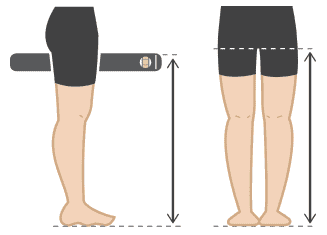Setting your bicycle seat height is crucial for achieving proper riding posture and comfort. A seat that is too low can cause knee pain and fatigue, while a seat that is too high can cause strain on the lower back and hips. If you are thinking of buying a full-suspension bike (and you should) then make sure you take the time to set up the seat height properly. Any bike that is typically ridden sitting down such as a commuter or trail cruiser really needs to be set properly. In this article, we’ll go over the steps you need to take to set your bicycle seat height properly.
Step 1: Measure your inseam

The first step in setting your bicycle seat height is to measure your inseam. This measurement will determine the correct height for your saddle. To measure your inseam, stand with your feet shoulder-width apart and place a book between your legs, up against your groin. Measure the distance from the top of the book to the floor.
Step 2: Calculate your saddle height
Once you have your inseam measurement, you can calculate your saddle height. Multiply your inseam measurement by 0.883 to get your saddle height in centimeters. This is the distance from the center of your bottom bracket (where your pedals attach to your bike) to the top of your saddle.
Step 3: Adjust the saddle height
Now that you have calculated your saddle height, you can adjust your saddle accordingly. To do this, loosen the seat post clamp and adjust the saddle height to the appropriate measurement. Make sure the seat post is inserted into the frame to the appropriate depth, and then tighten the clamp.
Step 4: Check your saddle position
Once you have adjusted your saddle height, you should check the position of your saddle. The saddle should be level and positioned so that your weight is evenly distributed across the saddle. You should also make sure that the saddle is centered on the seat post.
Step 5: Test your saddle height
Now that you have adjusted your saddle height and position, it’s time to test it out. Start by sitting on your bicycle and placing your foot on the pedal in the six o’clock position. Your knee should be slightly bent. If your knee is locked out or bent more than 90 degrees, your saddle height needs to be adjusted.
Once you have checked your saddle height, take your bike for a test ride. Ride for a few minutes and pay attention to how your knees and lower back feel. If your knees are painful or your lower back is strained, your saddle height may be too high or too low.
In conclusion, setting your bicycle seat height is an important step in achieving proper riding posture and comfort. By following these steps, you can ensure that your saddle is at the correct height and position, which will help you avoid discomfort and pain while riding. Remember to test your saddle height after adjusting it and make any necessary adjustments to achieve the perfect fit.
Happy riding!



